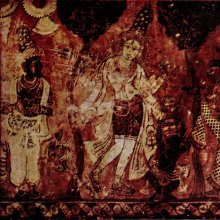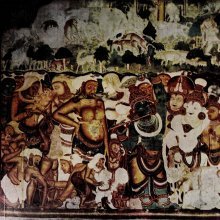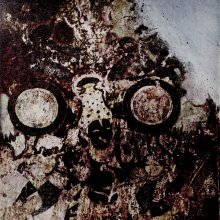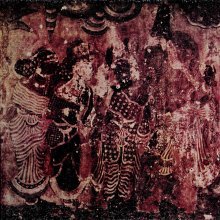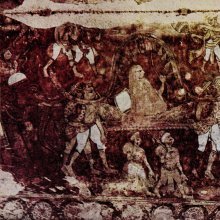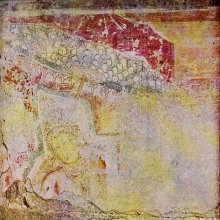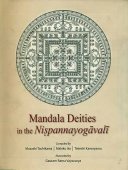Painter: 3 definitions
Introduction:
Painter means something in Jainism, Prakrit, the history of ancient India. If you want to know the exact meaning, history, etymology or English translation of this term then check out the descriptions on this page. Add your comment or reference to a book if you want to contribute to this summary article.
Images (photo gallery)
(+1 more images available)
In Jainism
General definition (in Jainism)
Source: academia.edu: Tessitori Collection IPainters in ancient India were able to paint the full body of persons merely by seeing their toe, according to the according to the Mṛgāvatīcaritra (dealing with the lives of Jain female heroes), which is included in the collection of manuscripts at the ‘Vincenzo Joppi’ library, collected by Luigi Pio Tessitori during his visit to Rajasthan between 1914 and 1919.—Accordingly, [...] A painter was able to paint the full body of Mṛgāvatī (daughter of king Śatānīka from Kosambī), seeing only her toe. This enraged the king. Although the painter explained that he owed this ability to the favour of a Yakṣa, the king cut his right hand. the painter was still able to paint with the left hand. In order to take revenge from the king, he brought Mṛgāvatī’s portrait to king Caṇḍapradyota in Ujjayinī. He wanted to conquer her and attacked Kosambi. Śatānīka died of dysentry out of fear.

Jainism is an Indian religion of Dharma whose doctrine revolves around harmlessness (ahimsa) towards every living being. The two major branches (Digambara and Svetambara) of Jainism stimulate self-control (or, shramana, ‘self-reliance’) and spiritual development through a path of peace for the soul to progess to the ultimate goal.
India history and geography
Source: archive.org: Bharatiya vastu-sastra (History)Painters in Ancient India, according to M. Foucher (Beginning of Buddhistic Art).—“From the Vedic times, Indian civilization had at its disposal the services not only of the carpenter, the wheelwright and the blacksmith, of the potter, the weaver and the fabricators of objects of prime necessity but also of those whom we call art-workers, painters, goldsmiths, carvers in ivory or wood etc.”.
Source: Singhi Jain Series: Ratnaprabha-suri’s Kuvalayamala-katha (history)Painters (making portraits on cloth-painting) in ancient India were vividly depicted in the Kathās (narrative poems) such as Uddyotanasūri in his 8th-century Kuvalayamālā (a Prakrit Campū, similar to Kāvya poetry).—Page 233.7: There is a mention of a young painter bringing a cloth-painting on which was depicted the portrait of the daughter of the king of Ujjayinī. The painting was marked with the purity of lines, richness of colours, according to different compositions, beautiful stripling or seedling to show the effect of surroundings or high and low surfaces and right measurements and representation of different lines of painting like sādṛśya. [...]

The history of India traces the identification of countries, villages, towns and other regions of India, as well as mythology, zoology, royal dynasties, rulers, tribes, local festivities and traditions and regional languages. Ancient India enjoyed religious freedom and encourages the path of Dharma, a concept common to Buddhism, Hinduism, and Jainism.
See also (Relevant definitions)
Full-text (+390): Citrakara, Rangajiva, Varnin, Varnacaraka, Varnata, Likhitri, Krinu, Taulika, Patakara, Citrakrit, Satsara, Attalikakara, Snehin, Tulika, Citraka, Ragin, Citari, Cittakara, Raktri, Rangajivaka.
Relevant text
Search found 73 books and stories containing Painter; (plurals include: Painters). You can also click to the full overview containing English textual excerpts. Below are direct links for the most relevant articles:
Trishashti Shalaka Purusha Caritra (by Helen M. Johnson)
Part 3: Story of the Yakṣa and painter < [Chapter VIII - Initiation of ṛṣabhadatta and devānandā]
Part 11: Reincarnation of Vaiśravaṇa (fifth of Malli’s six former friends) < [Chapter VI - Śrī Mallināthacaritra]
Part 22: Coronation of Sagara as Cakravartin < [Chapter IV - Conquest of Bharatavarṣa by Sagara]
Parables of Rama (by Swami Rama Tirtha)
Story 84 - Two ways of Acquiring Knowledge < [Chapter XI - Mind]
Story 98 - Clairvoyance created by Oneness < [Chapter XIV - Oneness]
Story 221 - The King and two painters < [Chapter XLI - Purity]
Scientist Painters < [January – March, 2003]
The Spirit of Chinese Painting < [April 1951]
Indian Art in London < [November-December 1934]
Harshacharita (socio-cultural Study) (by Mrs. Nandita Sarmah)
16.1. Drawing and Painting < [Chapter 6 - Other Socio-Cultural Aspects]
13. Various Types of Profession < [Chapter 6 - Other Socio-Cultural Aspects]
1. Similarities (8): Art and Architecture < [Chapter 8 - Comparative Society as described in the Kādambarī and the Harṣacarita]
Vishnudharmottara Purana (Art and Architecture) (by Bhagyashree Sarma)
7(h): Connection of Sentiments with the Paintings < [Chapter 5 - Painting and Image Making]
5. Preparation of Canvas before Painting < [Chapter 5 - Painting and Image Making]
1. Painting: The Concept < [Chapter 5 - Painting and Image Making]
Yoga-sutras (Ancient and Modern Interpretations) (by Makarand Gopal Newalkar)
Vibhūti-pāda and Vibhūti-yoga (Introduction) < [Book III - Vibhūti-pāda]
Related products
